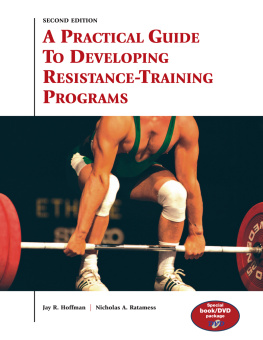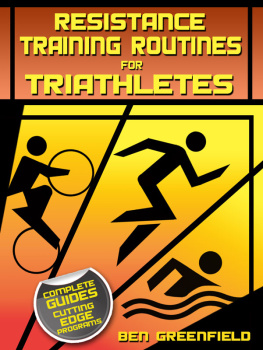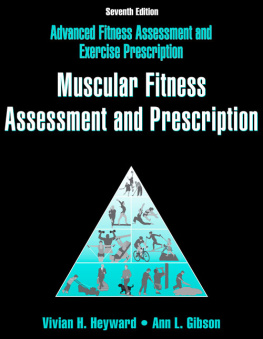Jay R. - A Practical Guide to Developing Resistance-Training Programs
Here you can read online Jay R. - A Practical Guide to Developing Resistance-Training Programs full text of the book (entire story) in english for free. Download pdf and epub, get meaning, cover and reviews about this ebook. year: 2008, publisher: Coaches Choice, genre: Romance novel. Description of the work, (preface) as well as reviews are available. Best literature library LitArk.com created for fans of good reading and offers a wide selection of genres:
Romance novel
Science fiction
Adventure
Detective
Science
History
Home and family
Prose
Art
Politics
Computer
Non-fiction
Religion
Business
Children
Humor
Choose a favorite category and find really read worthwhile books. Enjoy immersion in the world of imagination, feel the emotions of the characters or learn something new for yourself, make an fascinating discovery.
- Book:A Practical Guide to Developing Resistance-Training Programs
- Author:
- Publisher:Coaches Choice
- Genre:
- Year:2008
- Rating:4 / 5
- Favourites:Add to favourites
- Your mark:
- 80
- 1
- 2
- 3
- 4
- 5
A Practical Guide to Developing Resistance-Training Programs: summary, description and annotation
We offer to read an annotation, description, summary or preface (depends on what the author of the book "A Practical Guide to Developing Resistance-Training Programs" wrote himself). If you haven't found the necessary information about the book — write in the comments, we will try to find it.
Jay R.: author's other books
Who wrote A Practical Guide to Developing Resistance-Training Programs? Find out the surname, the name of the author of the book and a list of all author's works by series.
A Practical Guide to Developing Resistance-Training Programs — read online for free the complete book (whole text) full work
Below is the text of the book, divided by pages. System saving the place of the last page read, allows you to conveniently read the book "A Practical Guide to Developing Resistance-Training Programs" online for free, without having to search again every time where you left off. Put a bookmark, and you can go to the page where you finished reading at any time.
Font size:
Interval:
Bookmark:

A Practical Guide to Developing
Resistance-Training Programs
Jay R. Hoffman, Ph.D., FACSM, CSCS*D
Nicholas A. Ratamess, Ph.D., CSCS*D

2008 Coaches Choice. Second edition. All rights reserved. Printed in the United States.
No part of this book may be reproduced, stored in a retrieval system, or transmitted, in any form or by any means, electronic, mechanical, photocopying, recording, or otherwise, without the prior permission of Coaches Choice. Throughout this book, the masculine shall be deemed to include the feminine and vice versa.
ISBN: 978-1-58518-081-3
Library of Congress Control Number: 2007941281
Cover design: Studio J Art & Design
Book layout: Deborah Oldenburg
Coaches Choice
P.O. Box 1828
Monterey, CA 93942
www.coacheschoice.com

The destination is not what is importantits the road taken that makes it all worthwhile. Its those individuals that you meet in your journey that influence and impact the person that you become. I have been fortunate to work with good people that provided me the inspiration and direction to achieve my goalsDr. Carl Maresh, Dr. William Kraemer, Dr. Ari Shamis, Coaches Jim Calhoun, Meir Kaminsky, and Eric Hamilton, and the many other friends and colleagues that I have had the honor to work alongside. Finally, this book is dedicated to my familymy wife, Yaffa, and children, Raquel, Mattan, and Ariel. Your support makes the journey that much softer.
JRH
I want to thank Dr. Jim Peterson and all of the staff at Coaches Choice for their assistance with this book. I want to thank all of my colleagues who I have had the privilege of working with over the years for their inspiration and the knowledge Ive gained in resistance training. I want to thank Dr. William Kraemer for his guidance and my colleagues Drs. Avery Faigenbaum and Jie Kang for their feedback on the book. In addition, I want to thank Mattan Hoffman and Nathan Chebotar for their assistance with some of the photos used in this book. Lastly, this book is dedicated to my wife, Alison, my children, Jessica and Vinnie, and my parents, Nick and Veronica, for their love and support.
NAR

A Practical Guide to Developing Resistance-Training Programs is designed to help strength/conditioning and fitness professionals develop specific programs to enhance health and/or athletic performance. Resistance training is a modality that is currently recommended to most individuals. However, sensible guidelines need to be followed to provide an adequate stimulus for progression and minimize the risk of injuries. A multitude of programs can be used to successfully train athletes or clients. This book will provide the reader with the knowledge needed to design effective resistance-training programs. Therefore, athletes, coaches, personal trainers, fitness instructors, the general fitness population, and anyone using resistance training to enhance athletic performance or improve health can benefit from reading this book.
Chapter 1 provides the reader with a basic explanation of how muscles work. Understanding muscle function is important for understanding how programs can be developed and how muscles adapt to training. Chapter 2 provides the reader with the key principles that underlie resistance training. Chapter 3 discusses how the body prepares itself for a workout and the subsequent training-induced adaptations that take place. Chapters 4, 5, and 6 discuss the ins and outs of designing resistance-training programs, including the types of training modalities, how to manipulate training variables to enhance muscle strength, power, size, and endurance and reduce body fat, and how to cycle training over time for long-term progression. Chapter 7 discusses the importance of periodic testing to assess performance and evaluate training programs, and how you can select and incorporate appropriate fitness/performance tests. Chapter 8 presents an overview of facility design and includes a discussion of pertinent equipment needed in a facility. Chapters 9 and 10 provide illustrations, explanations, and variations for more than 40 exercises and examples of specific programs that may be followed or altered based on training goals.
A Practical Guide to Developing Resistance-Training Programs also features a companion DVD that is designed to help clarify and expand upon many of the key concepts and principles addressed in the book. Providing over three hours of ideas, insights, and information on practical guidelines involving resistance training, the DVD also covers the major topics included in the book. In addition, the DVD explains and shows, using actual demonstrators, how to perform the basic exercises covered in the book.

Basic Muscle Physiology
I n addition to providing a basic overview of skeletal muscle, this chapter covers basic muscle structure, types of muscle fibers, and how skeletal muscles contract. This chapter also explains how gradations in strength and movement can occur and the role of the central nervous system in producing muscular action.
Muscle Structure
Skeletal muscle is composed of several thousand cylindrical muscle cells, which are called fibers. The epimysium, a connective-tissue sheath, surrounds the entire muscle. If the epimysium did not exist, the fibers of the muscle would fray into countless directions and uniform skeletal movement could not occur. At both its proximal and distal ends, the muscle tapers to form a tendon, which is a strong, dense tissue that connects muscle to bone. The tendon is much smaller in magnitude than the muscle, but it has great tensile strength, allowing it to withstand the potentially large forces generated by the muscle during contraction. Connective-tissue structures within muscle (i.e., the epimysium, perimysium, and endomysium) become one with the tendons, which greatly helps in the transmission of force from muscle fibers to bone. Underneath the epimysium, groups of fibers are bound together, forming several bundles. Each bundle is termed a fasciculus and is surrounded by a layer of connective tissue called the perimysium. Similar to the epimysium, the perimysium is a protective sheath that allows the fasciculi to maintain their form and shape. Each fasciculus is made up of fibers that are also surrounded by a layer of connective tissue known as the endomysium. A membrane called the sarcolemma surrounds the cellular contents (e.g., mitochondria, ribosomes) that comprise each muscle fiber.
The total number of fibers within each muscle varies considerably and depends upon the muscles size and function. A fiber may extend the length of the muscle or it may merge with another fiber. A fiber may originate at the muscles proximal origin or it may originate in the middle of the muscle. The structure of a muscle can be seen in Figure 1-1.
A single muscle fiber is composed of many smaller units known as myofibrils. The myofibrils are made up of smaller units called
Font size:
Interval:
Bookmark:
Similar books «A Practical Guide to Developing Resistance-Training Programs»
Look at similar books to A Practical Guide to Developing Resistance-Training Programs. We have selected literature similar in name and meaning in the hope of providing readers with more options to find new, interesting, not yet read works.
Discussion, reviews of the book A Practical Guide to Developing Resistance-Training Programs and just readers' own opinions. Leave your comments, write what you think about the work, its meaning or the main characters. Specify what exactly you liked and what you didn't like, and why you think so.








